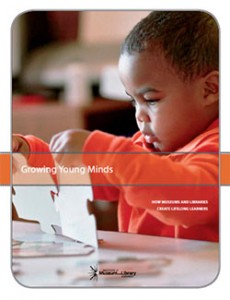This post originally appeared on the Fred Rogers Center Blog and appears here with permission.
by Kathleen Costanza

Far too often, children, and particularly low-income children, show up for school already behind, lacking the cognitive and social-emotional tools in their toolbox that make them ready to learn. In this highly competitive world, where education increasingly means greater security, falling behind so early in life can lead to disastrous consequences.
Educators do their best to bolster children’s skills once they arrive at school, but they shouldn’t have to go it alone. As the Annie E. Casey Foundation put it in their 2010 report on school readiness, children “need to have high-quality learning opportunities, beginning at birth and continuing in school and during out-of-school time, including summers ….”
A new report, “Growing Young Minds: How Museums and Libraries Create Lifelong Learners” published by the Institute of Museum and Library Services (IMLS), argues that museums and libraries can be that crucial piece in the puzzle of early-learning networks.
“Brain development during a child’s first few years—before he or she is in school—is critical for later learning,” Susan Hildreth, director of IMLS, told us. “But not all children have access to early learning opportunities and resources. Many children from low-income families don’t gain the language, cognitive, and social tools they need as a foundation,” she said. “These children have the most to gain from the accessible programs and services of museums and libraries.”
The report details the enormous role museums and libraries around the country already play in informal education for children, from acting as children’s first teachers to providing access to digital technologies—and how they can do more. The report features several Pittsburgh organizations as examples of institutions doing exceptional work in this area. We were delighted to see some of our own work among them—the authors mentioned the Fred Rogers Center Early Learning Environment (Ele), an online hub where educators, families, and others can find and share quality digital resources that support early learning and development.
Also in Pittsburgh, the Kids+Creativity Network collaborates with more than 100 organizations to exchange ideas and support connected learning opportunities. The IMLS report also spotlights the Children’s Museum of Pittsburgh for its ongoing research of informal learning environments, community partnerships, and MAKESHOP, a hands-on and digital learning space rooted in early learning, literacy, and STEM.
Despite these advances, the report also points out the gap by family income in museum and library attendance, arguing that now more than ever, libraries and museums should be emphasized as crucial parts of a national early-learning system. Only 36 percent of children from the lowest socioeconomic status visited libraries in their kindergarten year compared with 66 percent of children in the highest socioeconomic bracket. Likewise, only 43 percent of children in the lowest socioeconomic bracket visited a museum, versus 65 percent in the highest.
It seems that now, more than ever, libraries and museums can play an integral role in a national, early-learning system, and particularly for low-income children.
As Hildreth told us, “The disparity of access to learning resources has created a ‘knowledge gap’ with serious implications for society. If we can strengthen the country’s network of museums and libraries to be a greater force for early learning, effective learning opportunities for all children can deepen and grow.”
Hildreth emphasized that now is the time for policymakers to act and use libraries and museums, especially in cash-strapped communities, to their fullest capacity as key parts of an extensive informal learning infrastructure.
To support this effort, IMLS in 2013 provided $2.5 million in grants to museums and libraries to help children from low-income families reach the goal of reading at grade level. Nationally, two out of every three fourth graders were not proficient in reading in 2010, according to the National Assessment of Educational Progress. Worse, four of five fourth graders from low-income families were not proficient readers.
However, the report explains, it takes more than just funding to truly integrate museums and libraries into children’s early lives. State and federal policymakers, administrators, educators, and parents all play a role in supporting the valuable learning that takes place inside museums and libraries.
Below, from the report, are 10 ways museums and libraries contribute to early learning.
- Increasing high-quality early learning experiences
- Engaging and supporting families as their child’s first teachers
- Supporting development of executive function and “deeper learning” skills through literacy and STEM-based experience
- Creating seamless links across early learning and the early grades
- Positioning children for meeting expectations of the Common Core State Standards
- Addressing the summer slide
- Linking new digital technologies to learning
- Improving family health and nutrition
- Leveraging community partnerships
- Adding capacity to early learning networks

